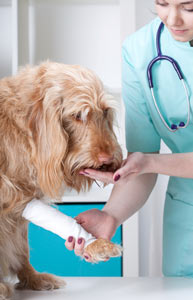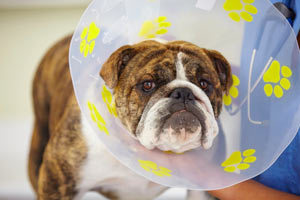Lick Granuloma: Causes, Treatments, and Prevention of Acral Lick Granuloma in Dogs

Lick granuloma is a common skin problem in dogs that is very frustrating for the dog, the owner, and the veterinarian. It is caused by the dog licking herself in the same area over and over. This causes trauma to that area of the skin and leads to a large wound, infection, and thickening of the skin. Lick granuloma most commonly occurs on the front of a lower leg, and the word "acral" simply means that the lesion occurs on an extremity.
Breeds, Gender, and Age Most Commonly Affected by Lick Granuloma in Dogs
- Male dogs are more commonly affected by lick granuloma than females.
- Middle-aged and older dogs are more likely to have a lick granuloma than younger dogs.
- Breeds that are more prone to developing lick granuloma include German Shepherds, Dobermans, Golden Retrievers, Labrador Retrievers, Irish Setters, Great Danes, and Dobermans.
Presentation and Signs of Lick Granuloma in Dogs
Dogs with lick granuloma have an area of skin, usually on the front of a lower leg, which is hairless and extremely thickened. The area may be red and/or oozing. The dog licks at the area obsessively.
Causes of Lick Granuloma in Dogs
Following is a list of common problems that may trigger a dog to lick incessantly at one area, causing a lick granuloma:
- Stress
- Boredom
- A wound
- Flea bite allergy
- Food allergy
- Inhalant allergy (also called atopy)
- Pain in the joint underlying the licked area
- Cancer (usually of the underlying bone, but may be soft tissue as well)
- Hypothyroidism
- Skin mites
Diagnosis of Lick Granuloma in Dogs
- Lick granuloma is diagnosed by a veterinarian's examination and discussion with the dog's owner about the history of the problem.
- Sometimes a biopsy of the area is done to positively diagnose the problem. This means that a small sample of tissue is taken and sent to the laboratory to be examined under a microscope.
Treatment of Lick Granuloma in Dogs
The treatment for lick granuloma hinges on finding and treating the underlying cause. In the meantime, the dog must be induced to leave the area alone, because the wound can't heal as long as she is constantly disturbing it. Below are some common treatments used for lick granuloma. Your veterinarian may start with one or a combination of these, and follow-up treatments may be needed based on your dog's response.
Do not give or apply any meds without checking with your veterinarian first. Some human medications are toxic to dogs if taken orally or licked off of the skin.
-
Topical medications (these medications do not treat the causes of lick granuloma, only the resultant lesions):
- Bad-tasting substances are often applied to lick granuloma lesions, usually without great success.
- Antibiotic creams are used on the area to control infection, and they sometimes help when the dog is concurrently kept away from the area with an e-collar or bandage.
- Topical corticosteroids are often used and do help sometimes, if the dog is also kept away from the area.
-
Oral medications (except for oral antibiotics and Trental, these medications are all treatments for the possible root causes of the obsessive licking behavior that causes lick granuloma):
-
Anti-anxiety medications are sometimes used if the cause of the lick granuloma is suspected to be nervousness or stress:
- Clomipramine, or Clomicalm, is a medication used for separation anxiety in dogs.
- Fluoxetine, which comes as Prozac or Reconcile, is used for separation and general anxiety in dogs.
- Amitryptyline, or Elavil, is used in dogs for separation anxiety and obsessive grooming disorders.
- Tranquilizers such as Acepromazine, or PromAce, are sometimes used to attempt to calm the dog when lick granuloma is suspected to be caused by stress or fear.
- Pentoxifylline, or Trental, is sometimes useful for healing lick granulomas. It increases oxygenation to affected tissue and has numerous anti-inflammatory traits.
-
Medications used to treat arthritis can be helpful in resolving lick granuloma if the underlying cause is joint pain.
- Non-steroidal anti-inflammatory medications (NSAIDs) such as Rimadyl and Deramaxx can decrease the pain associated with arthritis.
- Pain medications such as Tramadol are helpful in dogs, especially when they are used in conjunction with NSAIDs.
- Glucosamine supplements may help decrease inflammation and prevent further damage in arthritic joints. These should be in the form of glucosamine hydrochloride (HCl), not glucosamine sulfate, as glucosamine HCl has better bioavailability.
- Omega fatty acid supplements are also helpful in decreasing the inflammation in arthritic joints. These should be given in the form of fish or krill oils, not flaxseed. Fish and krill oils provide the correct forms of anti-inflammatory omega 3s, whereas flaxseed requires conversion to the anti-inflammatory compounds and dogs have limited amounts of the enzyme required to make this conversion.
-
Medications used to treat allergies can be helpful if they are determined to be the underlying cause of a dog's licking.
- Antihistamines help block the body's reaction to allergy-inducing substances.
- Corticosteroids have powerful anti-inflammatory effects, lowering the body's hyper-response to an allergen.
- Cyclosporine helps control allergies in dogs because it is a strong immunosuppressant drug.
- Long-term antibiotics, while not directed at any specific underlying cause of lick granuloma, can be helpful in healing the lesion, because there are often bacterial infections present that are complicating the body's ability to heal. These medications are often used for around 3 months.
-
- Elizabethan collars, also known as e-collars or cones, are often used in conjunction with other treatments to keep a dog from being able to reach a lick granuloma lesion to lick at it. Often, when the cone is removed, the dog begins licking in the same spot and creates the lesion all over again.
- Surgery is sometimes performed to remove the entire area of skin and soft tissue affected by a lick granuloma. This often results in a temporary fix only, as the dog is likely to begin licking again as soon as she has access to the site.
- Radiation treatment on lick granuloma lesions is sometimes done as a last resort, but it isn't very effective.

Home Care for Lick Granuloma in Dogs
Home care for lick granuloma in dogs will depend on the cause. Your veterinarian may ask you to give medications, apply bandages, and use an e-collar. Unless your dog is arthritic, in which case you want to maintain a moderate level of exercise, it is a good idea to do the following when you have a dog with lick granuloma:
- Increase the amount of playtime that you spend with your dog.
- Increase the amount of exercise that your dog gets.
- Provide more toys, especially interactive ones like Kongs and puzzle toys that will keep your dog's mind busy.
Prevention of Lick Granuloma in Dogs
Making sure that your dog always has plenty of exercise, sleep, playtime with you, and fun time with other dogs can help to decrease the chances of her developing stress-related lick granuloma. Otherwise, be sure to take your dog to the veterinarian at the first sign that she is focusing in on one spot to lick incessantly. The worse a lick granuloma gets, the harder it is to fix.
Prognosis for Lick Granuloma in Dogs
The prognosis for lick granuloma is guarded. Once a dog develops lick granuloma, it can be very difficult to treat. Sometimes one lesion is healed simply for the dog to begin a new one in a different spot. Finding and treating the underlying cause is crucial for long-term success. Since the cause is very commonly psychogenic, aggressive regimes of exercise, play, human contact, and enrichment can help achieve better resolution of this stubborn problem.
Alternative therapies for Lick Granuloma in Dogs
- Acupuncture has been used with some success in dogs with lick granuloma.
- DOGTV is a television channel that is tailored to dogs. It is a great companion for dogs that stay home alone often and can provide the right amounts of mental stimulation, physical exercise, and rest that your dog needs to help prevent him from becoming stressed or bored while you are away. This channel isn't simply pictures of cats and tennis balls: the images, contrast, volumes, and colors are all specifically chosen to best interest dogs, based on scientific research.
- Dog-Sitter videos are DVDs that can provide entertainment and company for your dog while you're away. This can reduce stress in dogs that are prone to lick granuloma.
New or Cutting Edge Therapies for Lick Granuloma in Dogs
- Laser treatment is being used in some cases of lick granuloma with success. The laser destroys the tissue, including deadening nerves, in the area in which it works. This may remove whatever feeling that keeps enticing the dog's attention back to that spot.
You May Also Like These Articles:
Dealing With Canine Scratching and Licking
DOGTV: A Great Way to Help Dogs That Are Home Alone All Day
Causes of Lameness in Dogs: An Overview
Panosteitis in Dogs: Growing Pains
Disclaimer: This website is not intended to replace professional consultation, diagnosis, or treatment by a licensed veterinarian. If you require any veterinary related advice, contact your veterinarian promptly. Information at DogHealth.com is exclusively of a general reference nature. Do not disregard veterinary advice or delay treatment as a result of accessing information at this site. Just Answer is an external service not affiliated with DogHealth.com.


